No products in the cart.
Great news! The Canada Post strike is over! We’re resuming deliveries to Canada!
Excellente nouvelle ! La grève de Postes Canada est terminée ! Nous reprenons les livraisons vers le Canada !
Great news! The Canada Post strike is over! We’re resuming deliveries to Canada!
Excellente nouvelle ! La grève de Postes Canada est terminée ! Nous reprenons les livraisons vers le Canada !
Diclofenac gel 5% tube in a pa...
$26.39 Original price was: $26.39.$23.99Current price is: $23.99.
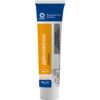

Loratadine Darnytsia tablets of 10 mg blister pack of 10 pcs
$15.99
Free Worldwide Shipping
Estimated delivery:
14 - 21 days
Categories: Allergy, Pain relief
Brand: Darnytsia
Loratidine is a tricyclic antihistamine with selective activity against peripheral H1 receptors. In most patients, when using the recommended dose, loratadine does not have a clinically significant sedative and anticholinergic effect. During long-term treatment, there were no clinically significant changes in indicators of vital body functions, laboratory tests, physical examination or ECG. Loratadine does not have a significant effect on H 2 -histamine receptors. The drug does not inhibit the absorption of norepinephrine and actually does not affect the function of the cardiovascular system or the activity of the heart rhythm driver.
Composition and form of release
Active substance: loratadine;
Composition
- 1 tablet contains loratadine 10 mg;
- excipients: corn starch, lactose monohydrate, microcrystalline cellulose, colloidal anhydrous silicon dioxide, croscarmellose sodium, magnesium stearate.
Release form
Tablets.
Pharmacological properties
Pharmacodynamics. Loratidine is a tricyclic antihistamine with selective activity against peripheral H1 receptors.
In most patients, when using the recommended dose, loratadine does not have a clinically significant sedative and anticholinergic effect. During long-term treatment, there were no clinically significant changes in indicators of vital body functions, laboratory tests, physical examination or ECG. Loratadine does not have a significant effect on H 2 -histamine receptors. The drug does not inhibit the absorption of norepinephrine and actually does not affect the function of the cardiovascular system or the activity of the heart rhythm driver.
Studies with skin tests for histamine after taking a single dose of 10 mg showed that the antihistamine effect occurs after 1-3 hours, reaches its peak after 8-12 hours and lasts for more than 24 hours. There was no development of resistance to the action of the drug after 28 days of loratadine use.
Clinical efficacy and safety. More than 10,000 men (aged 12 years and over) were treated with loratadine (10 mg tablets) in controlled clinical trials. Loratadine (tablets) 10 mg once daily was more effective than placebo and as effective as clemastine in improving symptoms (nasal and nonnasal) of allergic rhinitis. In these studies, somnolence occurred less frequently with loratadine than with clemastine, and with almost the same frequency as with terfenadine and placebo.
Among the participants of these studies (aged 12 and over), 1,000 patients with chronic idiopathic urticaria were enrolled in placebo-controlled studies. Loratadine at a dose of 10 mg once a day was more effective than placebo in the treatment of chronic idiopathic urticaria, as evidenced by a reduction in the severity of pruritus, erythema, and allergic rash. In these studies, the incidence of somnolence was similar between loratadine and placebo.
Children. Efficacy in children was similar to that in adults.
Pharmacokinetics. Absorption. Loratadine is quickly and well absorbed. The use of the drug during meals can slightly delay the absorption of loratadine, but this does not affect the clinical effect. Bioavailability indicators of loratadine and its active metabolite are proportional to the dose.
Distribution. Loratadine binds actively (97-99%) to blood plasma proteins, and its active metabolite – with moderate activity (73-76%).
In healthy volunteers, the half-life of loratadine and its active metabolite in blood plasma is about 1 and 2 hours, respectively.
Biotransformation. After oral administration, loratadine is rapidly and well absorbed and extensively metabolized during the first pass through the liver, mainly by CYP 3A4 and CYP 2D6. The main metabolite desloratadine is pharmacologically active and largely responsible for the clinical effect. Loratadine and desloratadine reach Cmax in the blood plasma (Tmax) after 1-1.5 and 1.5-3.7 hours, respectively, after drug use.
Breeding. About 40% of the dose is excreted with urine and 42% with feces within 10 days, mainly in the form of conjugated metabolites. About 27% of the dose is excreted in the urine during the first 24 hours. Less than 1% of the active substance is excreted in unchanged active form – as loratadine or desloratadine.
In healthy adult volunteers, the mean half-life of loratadine was 8.4 hours (range 3 to 20 hours), and that of the main active metabolite was 28 hours (range 8.8 to 92 hours).
In adult healthy volunteers, the average T½ of loratadine was 8.4 hours (range 3-20 hours), and the main active metabolite was 28 hours (range 8.8-92 hours).
Impaired kidney function. In patients with chronic kidney function disorders, AUC and C max values in the blood plasma of loratadine and its active metabolite increased compared to such values in patients with normal kidney function. The average T ½ of loratadine and its active metabolite did not differ significantly from the values in healthy people. In patients with chronic liver dysfunction, hemodialysis does not affect the pharmacokinetics of loratadine and its active metabolite.
Violation of liver function. In patients with chronic alcoholic liver damage, AUC and Cmax values of loratadine were 2 times higher, and their active metabolite did not change significantly when compared with such values in patients with normal liver function. T ½ of loratadine and its active metabolite is 24 and 37 hours, respectively, and increases depending on the severity of liver disease.
Elderly patients. The pharmacokinetic parameters of loratadine and its active metabolite were similar in healthy adult volunteers and healthy elderly volunteers.
Indication
Symptomatic treatment of allergic rhinitis and chronic idiopathic urticaria.
Application
Adults and children aged 12 and over. use the drug in a dose of 10 mg once a day.
For children aged 2-12 years with a body weight of more than 30 kg. Use the drug in a dose of 10 mg once a day.
For children aged 2-12 years with a body weight of less than 30 kg. Loratadine drugs should be used in a different dosage form.
Elderly patients and patients with renal insufficiency. There is no need to adjust the dose of the drug.
Patients with impaired liver function. Patients with severe liver dysfunction should adjust the dose due to a possible decrease in the clearance of loratadine (the recommended initial dose is 10 mg every other day).
Duration of treatment. The duration of the treatment course is determined by the doctor depending on the course of the disease.
Eating does not affect the effect of the drug.
Contraindication
Hypersensitivity to the active substance or other components of the drug.
Side effects
Brief description of the safety profile. in clinical trials involving adults and adolescents, when using loratadine at the recommended dose of 10 mg/day for indications that include allergic rhinitis and chronic idiopathic urticaria, adverse reactions were reported in 2% of patients (which is higher than in patients treated with placebo ). the most common adverse reactions reported at a higher rate than placebo were somnolence (1.2%), headache (0.6%), increased appetite (0.5%) and insomnia (0.1%). in clinical studies in children aged 2-12 years such undesirable phenomena as headache (2.7%), nervousness (2.3%) or fatigue (1%) were noted.
List of adverse reactions. Adverse reactions reported during the postmarketing period are listed below by system organ class. The frequency is defined as very often (≥1 / 10), often (from ≥1 / 100 to 1/10), infrequently (from ≥1 / 1000 to 1/100), rarely (from ≥1 / 10,000 to 1/1000 ), very rare (1/10,000) and unknown (impossible to establish based on available data).
In each group, adverse reactions are listed in order of decreasing seriousness.
From the side of the immune system: very rarely – hypersensitivity reactions, including anaphylaxis, angioedema.
From the side of the nervous system: very rarely – dizziness, drowsiness, headache, insomnia, convulsions.
From the side of the heart: very rarely – tachycardia, increased heartbeat.
Gastrointestinal tract: very rarely – nausea, vomiting, dry mouth, gastritis, increased appetite.
From the side of the liver and biliary tract: very rarely – pathological changes in liver function.
From the side of the skin and subcutaneous tissue: very rarely – rash, alopecia.
General disorders and reactions at the injection site Very rarely – fatigue.
Headache, nervousness, fatigue were noted in children aged 2-12 years.
Special instructions
The drug should be used with caution in patients with severe liver dysfunction.
The use of the drug should be stopped at least 48 hours before conducting skin tests, since antihistamines can neutralize or otherwise reduce the positive reaction when determining the skin reactivity index.
The drug contains lactose, so patients with rare hereditary forms of galactose intolerance, lactase deficiency or glucose-galactose malabsorption syndrome should not use Loratadine-Darnytsia tablets.
Use during pregnancy and breastfeeding. Pregnancy. There are very few data on the use of loratadine in pregnant women. Animal studies have not revealed direct or indirect adverse effects related to reproductive toxicity. As a precautionary measure, it is advisable to avoid using the drug during pregnancy.
Breast feeding. Physicochemical data indicate the excretion of loratadine and its metabolites in breast milk. Since the risk for the child cannot be excluded, the drug should not be used during breastfeeding.
Fertility. There are no data on the effect of the product on female or male fertility.
Children. The effectiveness and safety of the drug in children under 2 years of age have not been established.
The drug should be used in children over 2 years of age with a body weight of 30 kg.
The ability to influence the speed of reaction when driving vehicles or other mechanisms. The drug does not affect or has a minor effect on the ability to drive vehicles or other mechanisms. However, the patient should be informed about very rare cases of drowsiness, which may affect the ability to drive vehicles or other mechanisms.
Interactions
With simultaneous use with alcohol, the effects of Loratadine-Darnytsia are not enhanced, which is confirmed by studies of psychomotor function.
A potential interaction can be observed with the use of all known inhibitors of CYP 3A4 or CYP 2D6, which leads to an increase in the level of loratadine, and this, in turn, can be the reason for an increase in the frequency of adverse reactions.
In controlled studies, an increase in the concentration of loratadine in the blood plasma was reported after simultaneous use with ketoconazole, erythromycin and cimetidine, which was not accompanied by clinically significant changes (including on the ECG).
Children. Interaction studies with other drugs were conducted only with the participation of adult patients.
Overdose
With an overdose of loratadine, the frequency of anticholinergic symptoms increases.
Symptoms: drowsiness, tachycardia, headache.
Treatment: gastric lavage, taking activated charcoal, symptomatic and supportive therapy.
Loratadine is not removed by hemodialysis, nor is it known whether loratadine is removed by peritoneal dialysis.
After providing emergency care, the patient should remain under medical supervision.
Storage conditions
In the original packaging at a temperature not higher than 25 °C.
Be the first to review “Loratadine Darnytsia tablets of 10 mg blister pack of 10 pcs” Cancel reply
You may also like


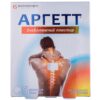
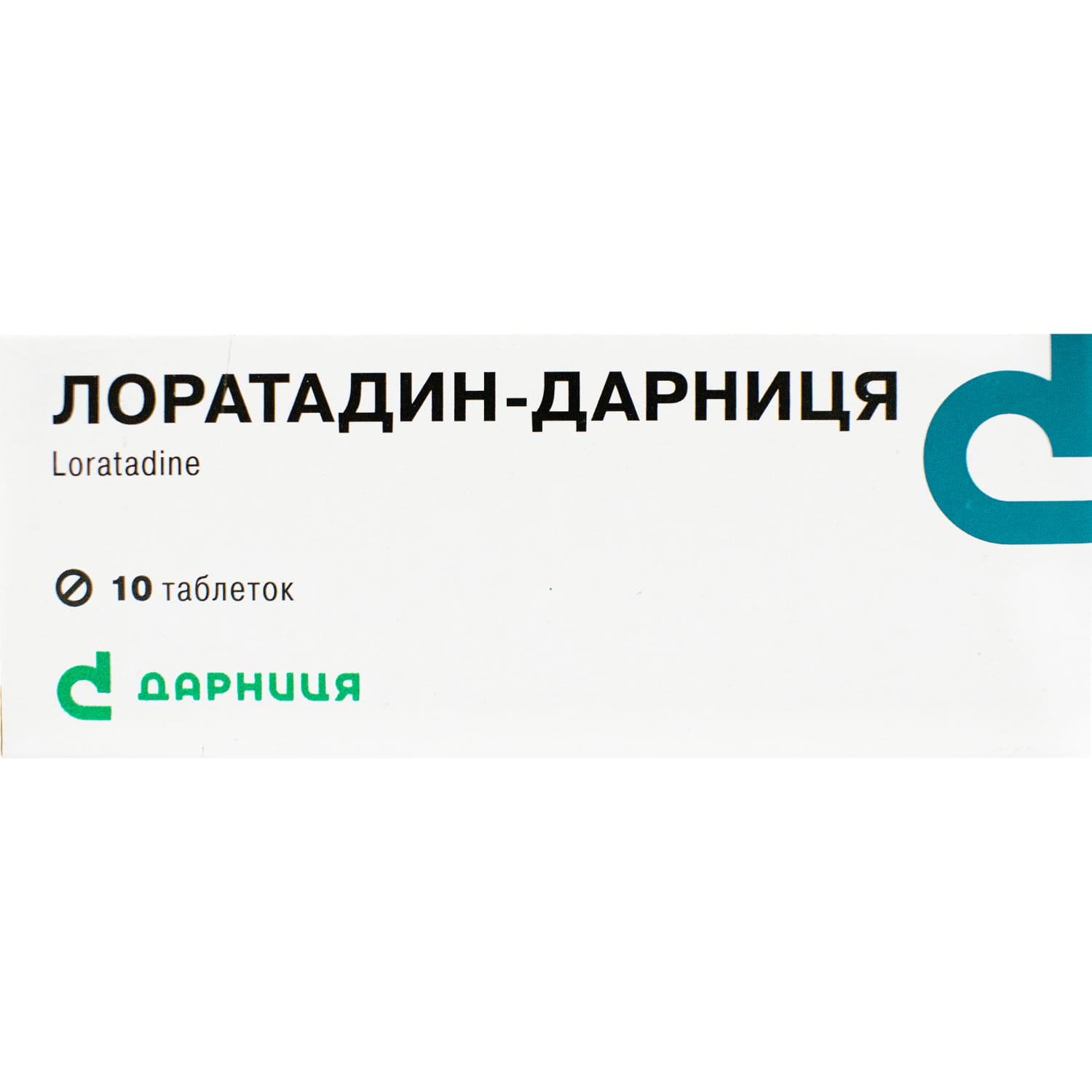
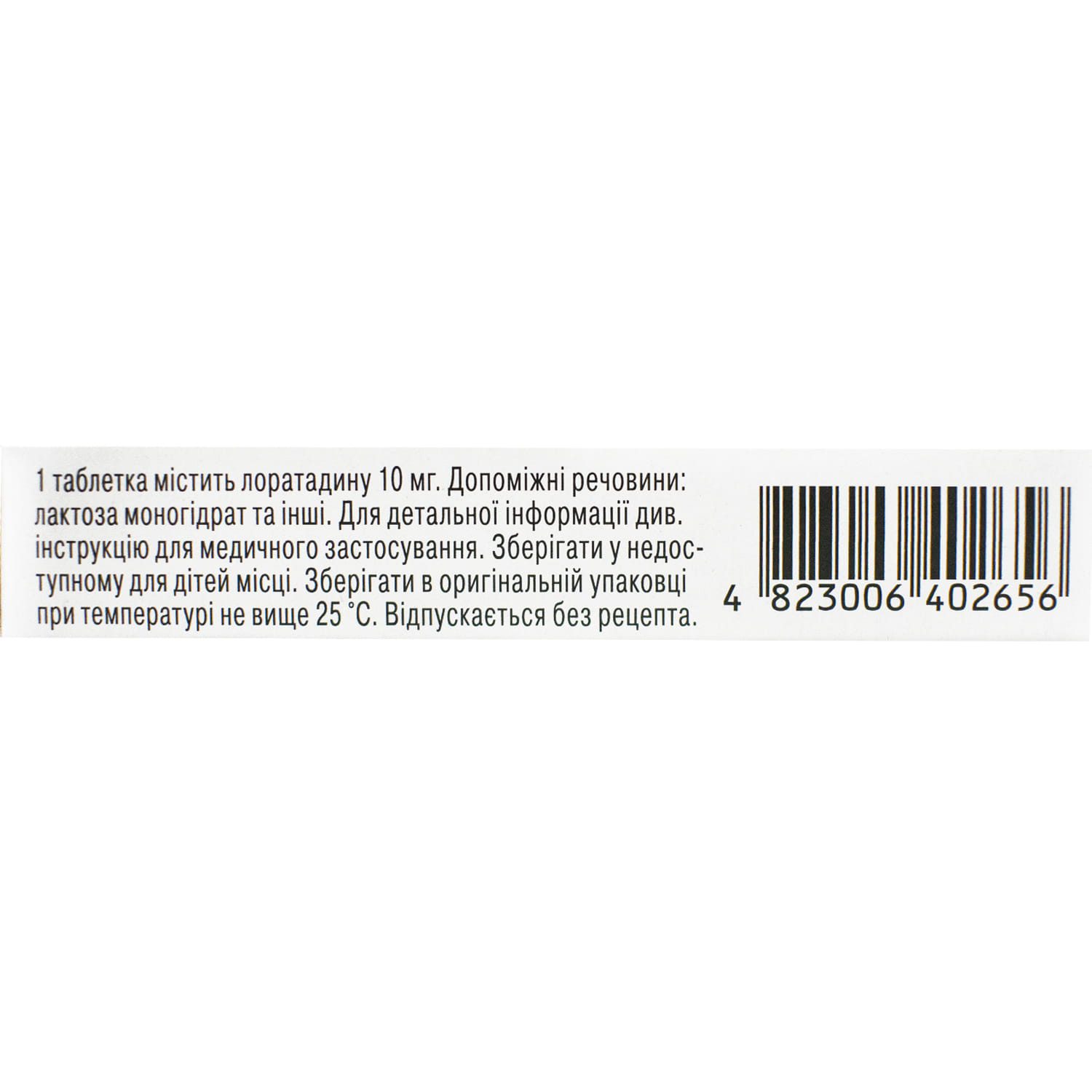
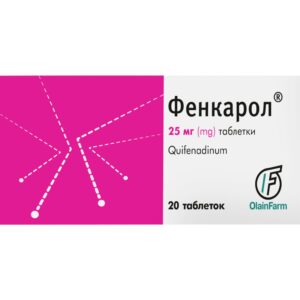
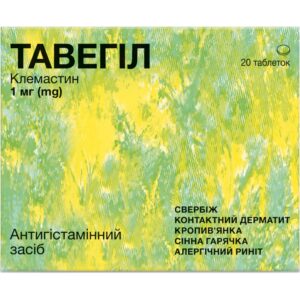
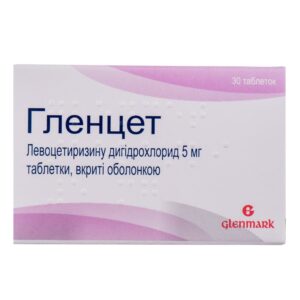
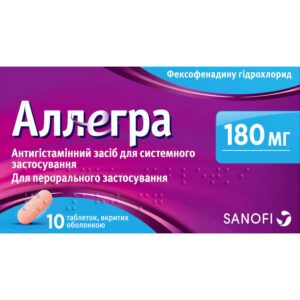
Reviews
There are no reviews yet.